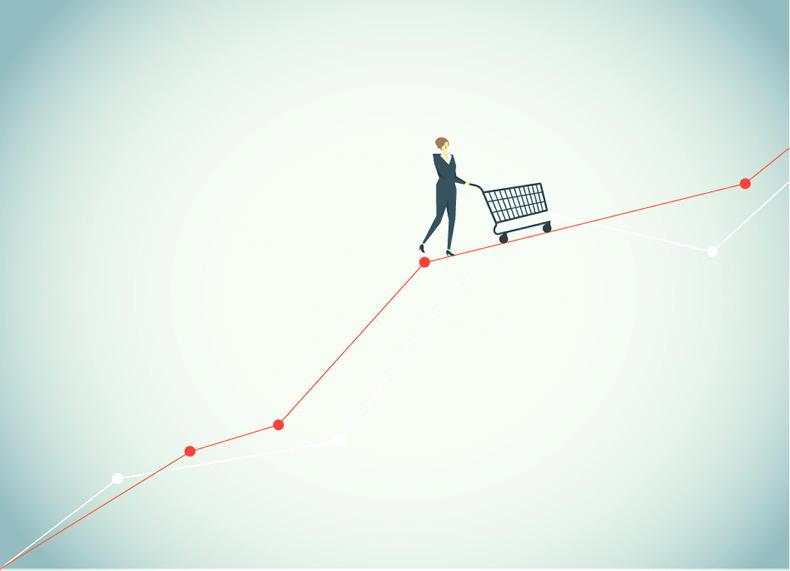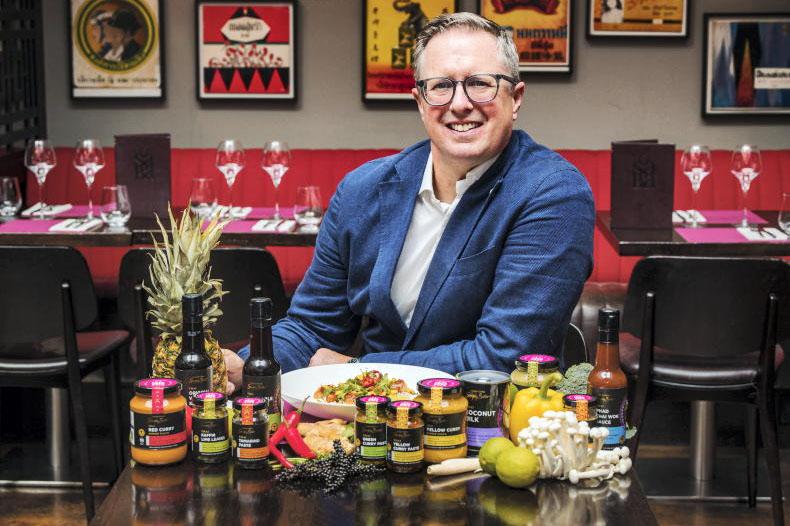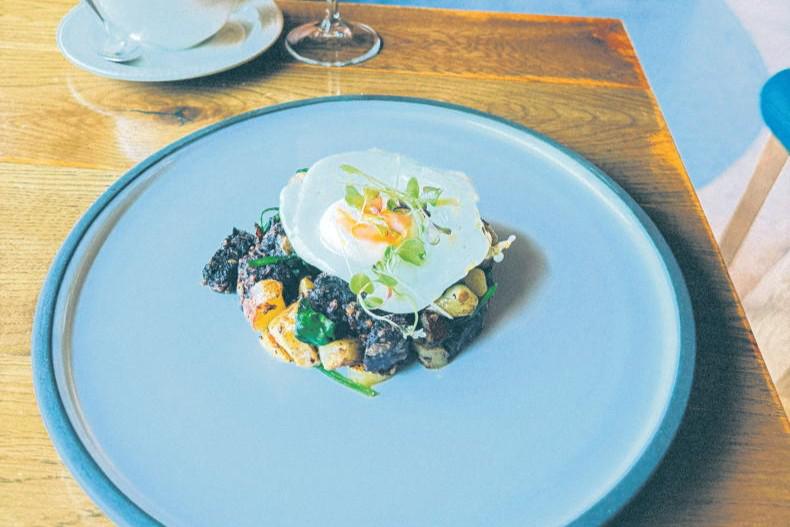It’s not your imagination; if you’ve noticed the total at the till has been higher than usual in recent weeks, it’s not because of the fancy packet of biscuits you’ve thrown in.
Food prices have steadily increased by up to 10% for some of our staple items as food inflation for the month of January reached 2%, the highest in the 10 years since the recession.
So what is happening in your shopping trolley?
Irish Country Living has analysed 15 staple items that readers purchase every week. We’re comparing recent prices to how much they cost this time last year, according to Central Statistic Office (CSO) figures, as well as their price 10 years ago, when food prices spiked during the recession.
Interestingly, the biggest year-on-year spikes that we are observing are on the items which are mostly imported. The steepest price hike in our basket of goods was spaghetti which jumped from €1 to €1.10, an increase of 10% while tinned tomatoes went up from 82c/tin last year to 90c/tin now, a 9% increase. Other spikes include white sliced pan (up 7%), bananas (up 6%), a medium chicken (up 5%) and self-raising flour (up 4%).
Interestingly, items that have remained fairly stable include milk, eggs and butter. Potatoes are one of the few items that are cheaper now, compared to last year.
Factors at play
This isn’t just an Irish issue. Although our food inflation now sits at 2%, the European average is 3.6% and in the UK it is at 4.2%.
Disruptions to global supply chains and massively rising input costs are two of the biggest factors affecting price. Feed has gone up between 30-40% and fertiliser costs have increased by 200% and given that Russia is the largest exporter of fertiliser in the world, these prices will continue on an upward trajectory. Energy costs have increased by up to 25% while packaging is up 15%. These all have an impact.
Retail expert and Technological University Dublin (TUD) academic, Damian O’Reilly explains more:
“If you look more specifically at items, the likes of pasta and bread have seen the biggest hikes and this is Brexit having an input. The majority of our flour is coming from the UK and there is a Canadian constituent in the flour which brings an extra tariff because its coming from a third country.
“There are also price hikes on biscuits, the majority of which we import from the UK as well as crisps as the price of cooking oils is up by 8%.”
Farmers are really feeling the impact and although some producers have had a little success with price negotiations
Why aren’t we seeing similar price hikes in Irish-produced items, especially in light of the fact that recent reports in the Irish Farmers Journal show input costs for Irish farmers have increased by 40%?
“We might not be seeing these prices increases at the tills right now but we will see increases in the coming months,” Damian says. “Farmers are really feeling the impact and although some producers have had a little success with price negotiations, it is not in line with the input increases.
“Similarly, it is likely retailers are absorbing some of the costs and margins are being squeezed in order to price match and hold on to customers.”
The bigger picture
Damian says the situation has to be looked at holistically and not just what has happened in the past few months. “Since the discount retailers such as Lidl and Aldi entered the market 20 years ago, we have experienced significant price deflation.”
CSO figures outlined in the graph below proves this. Ten years ago, 1kg of cheddar was €11.36. Today it is €8.97. A pound of jam was €1.90, it’s now 95c and a full chicken was €5.51 in 2012 while today it is €4.79.
Damian continues: “The discounters drove prices down and it’s still happening. This is because they can’t grow organically anymore. Lidl have about 160 stores and Aldi have about 150 stores, they are in nearly every town in the country.
“They have reached saturation point in terms of their positioning so what they are really pushing is price, creating a competitive battlefield and two of the key areas that they have targeted is meat and vegetable products. These are the prices that they have kept low to get people in the door.”
As a result, these are the products that other retailers price match. “Lidl and Aldi’s business model is to stock about 1,800 products. The other large retailers – the likes of Tesco, Dunnes, SuperValu – they could stock anywhere up to 20,000 products. So when Tesco for example, says they are price matching 2,000, these aren’t random products. They are price matching the items on sale in the discounters.”
Special offers
Another way, costs are being absorbed that we might not be noticing as much is special offers.
The latest research from Kantar shows that the number of products being sold on promotion has dropped by 3% compared with last January.
Emer Healy, senior retail analyst at Kantar says: “It is a fair assumption that this is one of the ways that retailers are passing on increased prices.
“Instead of rising the price of staples, they are reducing the amount of special offers.
In normal times, branded products do very well seasonally, especially during Christmas and Easter
“This is a really subtle move. Consumers won’t notice this as they walk around the supermarket but it is having an impact at the till.”
Emer says that Kantar’s latest research shows that consumer behavior is reflecting these price increases.
“In normal times, branded products do very well seasonally, especially during Christmas and Easter.
“Generally, they have a higher price and are seen as ways to treat ourselves. Throughout 2020 and a lot of 2021, brands outperformed own-label month after month as people were isolating and couldn’t eat out.
“Obviously, we would see more of a return to normal times, now that restrictions have lifted but the shift back to private label which would be seen as cheaper products has been steep and certainly indicates that there is pressure on people’s finances.”
While this has explained what is happening in the past few months, the next few months are impossible to predict. Damian O’Reilly says: “In normal times, you would say that we will see an increase in food prices this year in line with increased input costs. However, given the situation in Ukraine, it is impossible to predict what those impacts will be.
Forty per cent of all retail spend is within the grocery story, it’s worth about €15bn to the Irish economy
“Whatever the situation though, we are always going to have fluctuations in food prices, that is the nature of the game. I strongly believe we need a food or grocery ombudsman.
“Forty per cent of all retail spend is within the grocery story, it’s worth about €15bn to the Irish economy. This warrants an ombudsman, someone who can look after what is going on, be a third-party negotiator. Small producers are negotiating with big retailers and its not an equal playing field.”
According to the Consumer Price Index, there has been a 2% increase in food prices, from January 2021 to January 2022.Prices of food and non-alcoholic beverages increased due to higher prices across a range of products such as bread and cereals, meat and mineral waters, soft drinks, fruit and vegetable juices.Coinciding with the introduction of minimum unit alcohol pricing, in January 2022, take-home alcoholic beverages price on average were up almost 17% in the last month and almost 9% from a year ago. According to Kantar, the number of products being sold on promotion has dropped by 3% compared with last January. Dunnes Stores currently holds the position as Ireland’s largest retailer with 23.1% of the market. SuperValu follows closely with a market share of 22.2% while Tesco is just 0.1 percentage points behind this at 22.1%. Lidl now holds an 11.8% share, with Aldi at 11.6%. The power of consumer psychology
While you are browsing the supermarket shelves, there are hundreds of marketing techniques at play, influencing what you put in your trolley and what supermarkets want you to buy. Often this is dictated by supply chains and stock, the items retailers want to shift in order to decrease supermarket waste.
Dr Dean McDonnell, member of the Psychological Society of Ireland and lecturer of Psychology in the Institute of Technology in Carlow explains a few techniques that influence our spending.
1 Positioning of products
You may not be aware but the second you enter a supermarket, retailers are appealing to all your senses. Bakeries and rotisseries, along with fresh flowers, are located just inside the door, the wonderful aromas drawing you in, making you feel hungry. This isn’t an accident, nor is the fact that dairy is located at the very back of the supermarket. Often we might just need a pint of milk, but we have to go past rows and rows of shelves to get there.
Special offers are often located in the same place every week, usually at the end of aisles. They are in a position that stands out, to attract our attention. In fact, its position becomes a habit. We go there for those special offers. We are now hard-wired to think this is where we go to get the best deals. But some weeks, there might not be any deals there, or the deals aren’t as good. Often this is where you’ll find the bulk stock, such as seasonal vegetables that retailers want to push.
2 Telling the story
In recent years, all the big retailers have been telling the story of the local farmers and producers they support. Walking into the supermarket, often you’ll see big photographs of Irish farmers in the fields picking their vegetables. They want you to know that their morals and ethos are aligned with yours; that they have a very similar social case. But that might not always be the cause on shelf. You may be surrounded by pictures of Irish farmers, but when you pick up a packet of strawberries, you may assume there are local, but they could in fact be from Spain with a bigger mark-up for the retailer but you’re too influenced by the story they tell to notice.
3 Reciprocity
Reciprocity is the concept of a mutual exchange and consumers often feel under pressure to give something back. This is why the idea of free samples worked so well in supermarkets (pre-COVID-19). You get a sample of a sausage for example, and then you feel under pressure to buy. That is also why concepts such as spend X and you’ll give you €10 off your next shop work. Not only do you want the deal, there is the idea of giving back because they offered you this perk. It’s also why people buy two products when something is half price. But you have to ask, do you need that second bag of carrots? Will it be used in your house? Retailers put these items on special offer to reduce supermarket waste but is it contributing to your household waste?
According to the CSO, prices on average, as measured by the CPI, were 5% higher in January compared with January 2021.
Read more
Our love affair with convenience foods
Hope is not a strategy when it comes to our most basic need – food!
It’s not your imagination; if you’ve noticed the total at the till has been higher than usual in recent weeks, it’s not because of the fancy packet of biscuits you’ve thrown in.
Food prices have steadily increased by up to 10% for some of our staple items as food inflation for the month of January reached 2%, the highest in the 10 years since the recession.
So what is happening in your shopping trolley?
Irish Country Living has analysed 15 staple items that readers purchase every week. We’re comparing recent prices to how much they cost this time last year, according to Central Statistic Office (CSO) figures, as well as their price 10 years ago, when food prices spiked during the recession.
Interestingly, the biggest year-on-year spikes that we are observing are on the items which are mostly imported. The steepest price hike in our basket of goods was spaghetti which jumped from €1 to €1.10, an increase of 10% while tinned tomatoes went up from 82c/tin last year to 90c/tin now, a 9% increase. Other spikes include white sliced pan (up 7%), bananas (up 6%), a medium chicken (up 5%) and self-raising flour (up 4%).
Interestingly, items that have remained fairly stable include milk, eggs and butter. Potatoes are one of the few items that are cheaper now, compared to last year.
Factors at play
This isn’t just an Irish issue. Although our food inflation now sits at 2%, the European average is 3.6% and in the UK it is at 4.2%.
Disruptions to global supply chains and massively rising input costs are two of the biggest factors affecting price. Feed has gone up between 30-40% and fertiliser costs have increased by 200% and given that Russia is the largest exporter of fertiliser in the world, these prices will continue on an upward trajectory. Energy costs have increased by up to 25% while packaging is up 15%. These all have an impact.
Retail expert and Technological University Dublin (TUD) academic, Damian O’Reilly explains more:
“If you look more specifically at items, the likes of pasta and bread have seen the biggest hikes and this is Brexit having an input. The majority of our flour is coming from the UK and there is a Canadian constituent in the flour which brings an extra tariff because its coming from a third country.
“There are also price hikes on biscuits, the majority of which we import from the UK as well as crisps as the price of cooking oils is up by 8%.”
Farmers are really feeling the impact and although some producers have had a little success with price negotiations
Why aren’t we seeing similar price hikes in Irish-produced items, especially in light of the fact that recent reports in the Irish Farmers Journal show input costs for Irish farmers have increased by 40%?
“We might not be seeing these prices increases at the tills right now but we will see increases in the coming months,” Damian says. “Farmers are really feeling the impact and although some producers have had a little success with price negotiations, it is not in line with the input increases.
“Similarly, it is likely retailers are absorbing some of the costs and margins are being squeezed in order to price match and hold on to customers.”
The bigger picture
Damian says the situation has to be looked at holistically and not just what has happened in the past few months. “Since the discount retailers such as Lidl and Aldi entered the market 20 years ago, we have experienced significant price deflation.”
CSO figures outlined in the graph below proves this. Ten years ago, 1kg of cheddar was €11.36. Today it is €8.97. A pound of jam was €1.90, it’s now 95c and a full chicken was €5.51 in 2012 while today it is €4.79.
Damian continues: “The discounters drove prices down and it’s still happening. This is because they can’t grow organically anymore. Lidl have about 160 stores and Aldi have about 150 stores, they are in nearly every town in the country.
“They have reached saturation point in terms of their positioning so what they are really pushing is price, creating a competitive battlefield and two of the key areas that they have targeted is meat and vegetable products. These are the prices that they have kept low to get people in the door.”
As a result, these are the products that other retailers price match. “Lidl and Aldi’s business model is to stock about 1,800 products. The other large retailers – the likes of Tesco, Dunnes, SuperValu – they could stock anywhere up to 20,000 products. So when Tesco for example, says they are price matching 2,000, these aren’t random products. They are price matching the items on sale in the discounters.”
Special offers
Another way, costs are being absorbed that we might not be noticing as much is special offers.
The latest research from Kantar shows that the number of products being sold on promotion has dropped by 3% compared with last January.
Emer Healy, senior retail analyst at Kantar says: “It is a fair assumption that this is one of the ways that retailers are passing on increased prices.
“Instead of rising the price of staples, they are reducing the amount of special offers.
In normal times, branded products do very well seasonally, especially during Christmas and Easter
“This is a really subtle move. Consumers won’t notice this as they walk around the supermarket but it is having an impact at the till.”
Emer says that Kantar’s latest research shows that consumer behavior is reflecting these price increases.
“In normal times, branded products do very well seasonally, especially during Christmas and Easter.
“Generally, they have a higher price and are seen as ways to treat ourselves. Throughout 2020 and a lot of 2021, brands outperformed own-label month after month as people were isolating and couldn’t eat out.
“Obviously, we would see more of a return to normal times, now that restrictions have lifted but the shift back to private label which would be seen as cheaper products has been steep and certainly indicates that there is pressure on people’s finances.”
While this has explained what is happening in the past few months, the next few months are impossible to predict. Damian O’Reilly says: “In normal times, you would say that we will see an increase in food prices this year in line with increased input costs. However, given the situation in Ukraine, it is impossible to predict what those impacts will be.
Forty per cent of all retail spend is within the grocery story, it’s worth about €15bn to the Irish economy
“Whatever the situation though, we are always going to have fluctuations in food prices, that is the nature of the game. I strongly believe we need a food or grocery ombudsman.
“Forty per cent of all retail spend is within the grocery story, it’s worth about €15bn to the Irish economy. This warrants an ombudsman, someone who can look after what is going on, be a third-party negotiator. Small producers are negotiating with big retailers and its not an equal playing field.”
According to the Consumer Price Index, there has been a 2% increase in food prices, from January 2021 to January 2022.Prices of food and non-alcoholic beverages increased due to higher prices across a range of products such as bread and cereals, meat and mineral waters, soft drinks, fruit and vegetable juices.Coinciding with the introduction of minimum unit alcohol pricing, in January 2022, take-home alcoholic beverages price on average were up almost 17% in the last month and almost 9% from a year ago. According to Kantar, the number of products being sold on promotion has dropped by 3% compared with last January. Dunnes Stores currently holds the position as Ireland’s largest retailer with 23.1% of the market. SuperValu follows closely with a market share of 22.2% while Tesco is just 0.1 percentage points behind this at 22.1%. Lidl now holds an 11.8% share, with Aldi at 11.6%. The power of consumer psychology
While you are browsing the supermarket shelves, there are hundreds of marketing techniques at play, influencing what you put in your trolley and what supermarkets want you to buy. Often this is dictated by supply chains and stock, the items retailers want to shift in order to decrease supermarket waste.
Dr Dean McDonnell, member of the Psychological Society of Ireland and lecturer of Psychology in the Institute of Technology in Carlow explains a few techniques that influence our spending.
1 Positioning of products
You may not be aware but the second you enter a supermarket, retailers are appealing to all your senses. Bakeries and rotisseries, along with fresh flowers, are located just inside the door, the wonderful aromas drawing you in, making you feel hungry. This isn’t an accident, nor is the fact that dairy is located at the very back of the supermarket. Often we might just need a pint of milk, but we have to go past rows and rows of shelves to get there.
Special offers are often located in the same place every week, usually at the end of aisles. They are in a position that stands out, to attract our attention. In fact, its position becomes a habit. We go there for those special offers. We are now hard-wired to think this is where we go to get the best deals. But some weeks, there might not be any deals there, or the deals aren’t as good. Often this is where you’ll find the bulk stock, such as seasonal vegetables that retailers want to push.
2 Telling the story
In recent years, all the big retailers have been telling the story of the local farmers and producers they support. Walking into the supermarket, often you’ll see big photographs of Irish farmers in the fields picking their vegetables. They want you to know that their morals and ethos are aligned with yours; that they have a very similar social case. But that might not always be the cause on shelf. You may be surrounded by pictures of Irish farmers, but when you pick up a packet of strawberries, you may assume there are local, but they could in fact be from Spain with a bigger mark-up for the retailer but you’re too influenced by the story they tell to notice.
3 Reciprocity
Reciprocity is the concept of a mutual exchange and consumers often feel under pressure to give something back. This is why the idea of free samples worked so well in supermarkets (pre-COVID-19). You get a sample of a sausage for example, and then you feel under pressure to buy. That is also why concepts such as spend X and you’ll give you €10 off your next shop work. Not only do you want the deal, there is the idea of giving back because they offered you this perk. It’s also why people buy two products when something is half price. But you have to ask, do you need that second bag of carrots? Will it be used in your house? Retailers put these items on special offer to reduce supermarket waste but is it contributing to your household waste?
According to the CSO, prices on average, as measured by the CPI, were 5% higher in January compared with January 2021.
Read more
Our love affair with convenience foods
Hope is not a strategy when it comes to our most basic need – food!










SHARING OPTIONS